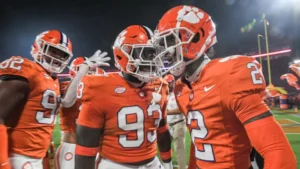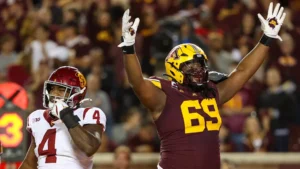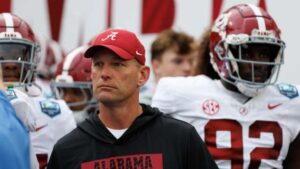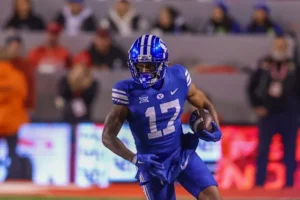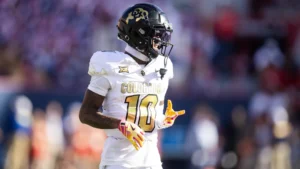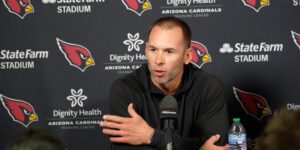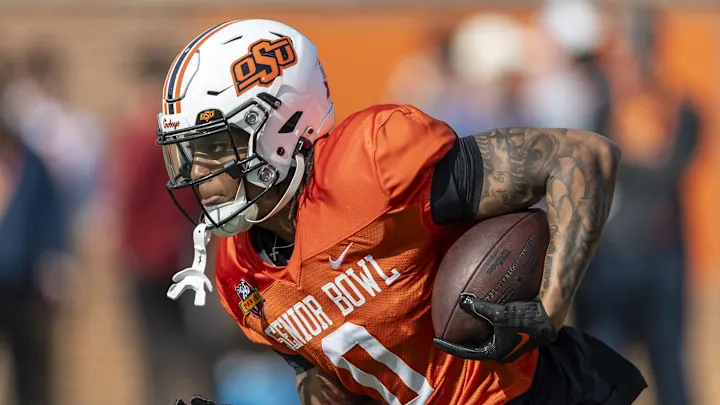
“Red Flag Radar: One Prospect the Cardinals Should Steer Clear of in Every Round of the NFL Draft”
The NFL Draft is a high-stakes game of calculated risk and reward. With every selection, general managers attempt to mold the future of their franchise. For the Arizona Cardinals, a team in the middle of a rebuild under head coach Jonathan Gannon and GM Monti Ossenfort, hitting on their 2025 draft picks could accelerate a return to playoff contention. However, with 11 total picks and the opportunity to address numerous roster needs, one misstep per round could be the difference between sustainable success and another year in the NFC West basement.
The Cardinals own the No. 4 overall pick in the first round, giving them a chance to land a cornerstone player. But every round presents its own set of traps—players with alluring highlight reels but underlying red flags. Whether it’s durability concerns, system fits, off-field baggage, or lack of elite traits, certain prospects could be more trouble than they’re worth for Arizona’s current direction. Here’s a breakdown of one prospect the Cardinals should avoid in every round of the 2025 NFL Draft.
In the first round, the temptation to chase upside often trumps safer bets. Georgia edge rusher Mykel Williams is a name that has risen up draft boards thanks to his physical traits and occasional flashes of brilliance. But for Arizona, he represents a risky investment. Williams certainly looks the part—long, explosive, and with five-star pedigree—but he never consistently dominated in the SEC. His pass-rush plan lacks nuance, and he often disappears in big games. The Cardinals need immediate contributors on defense, not developmental projects with boom-or-bust potential. With someone like Alabama’s Dallas Turner or Ohio State’s JT Tuimoloau likely to be available, reaching for Williams could set back their edge room for years.
Moving into the second round, one name that may catch Arizona’s eye is Michigan wide receiver Cornelius Johnson. Standing at 6-foot-3, he offers size and decent speed, but his production in college never matched the tools. Arizona already has a big-bodied pass-catcher in Michael Wilson and is searching for explosive playmakers who can stretch the field and separate quickly. Johnson struggles against press coverage and lacks consistent hands. With Kyler Murray under center, the Cardinals need weapons who can create after the catch and thrive in space. Johnson projects more as a WR3 or WR4 in the pros, and Arizona can’t afford to use such a valuable pick on a depth piece.
In the third round, centers and interior linemen become hot commodities, and Duke’s Graham Barton is a name that might get some buzz. He’s experienced, smart, and versatile, but his best position is still a mystery. Barton played tackle in college but lacks the length for the outside at the next level. While some project him to center or guard, he’s never played those positions full-time. The Cardinals have invested heavily in reshaping the offensive line, but they need plug-and-play linemen, not experiments. Drafting Barton may result in a lengthy adjustment period that Arizona can’t afford as they try to protect their franchise quarterback.
By the time the fourth round rolls around, value becomes the name of the game. That doesn’t mean teams should gamble on medical red flags, which is why Arizona should be wary of Tennessee linebacker Aaron Beasley. Beasley is an instinctive player with good range, but his injury history raises questions. The Cardinals already have a thin linebacker corps and can’t afford to spend mid-round capital on someone who may struggle to stay on the field. Linebackers drafted in this range often become core special teamers or rotational defenders, and Arizona needs durability to justify the investment. Beasley’s instincts don’t outweigh the availability concerns, especially given how much time he’s missed throughout his collegiate career.
In the fifth round, teams often begin swinging on traits over tape. That’s where Stanford cornerback Ethan Bonner comes in. At 6-foot-1 with great length and a smooth stride, Bonner checks a lot of boxes from a physical standpoint. But he’s a limited technician who hasn’t faced consistent top-level competition. Bonner is a classic “looks like Tarzan, plays like Jane” prospect who might impress in workouts but struggles in live action. Arizona’s secondary has some promising youth, but it also needs reliable depth. Bonner’s inconsistent ball skills and questionable tackling make him a poor fit in Gannon’s defense, which relies heavily on physical, disciplined corner play. There will be better bets on the board.
Round six is where teams often try to find overlooked talent or stash-and-develop players. However, it’s also a round where some collegiate production doesn’t translate to the next level, which is why Arizona should avoid Oregon running back Bucky Irving. He’s a compact back with great college stats, but his running style—reliant on quickness and cutbacks—may not hold up in the NFL. He struggles in pass protection, has a slight frame, and lacks the long speed that typically threatens defenses. Arizona has a solid rotation with James Conner and Emari Demercado, and if they’re adding another back, it should be one who adds a distinct dimension—either a power runner or a true burner. Irving falls awkwardly in the middle, and that makes him replaceable.
By the time the seventh round arrives, most prospects are longshots, but smart teams still hunt for special teams value or developmental potential. One player Arizona should pass on here is Kansas quarterback Jason Bean. His athleticism is legit, and he flashed some electric moments in college. But his inconsistent accuracy, poor decision-making, and erratic pocket presence are all glaring issues. The Cardinals don’t need a project quarterback when they already have a stable room with Kyler Murray and capable backups. Bean might intrigue as a gadget option or emergency quarterback, but that’s a luxury Arizona can’t afford with so many other holes to fill. They’d be better served using their final pick on a defensive back or interior lineman with special teams upside.
Ultimately, the NFL Draft isn’t just about finding players—it’s about avoiding the wrong ones. For a team like the Cardinals, every pick matters in building a roster that can support Kyler Murray, compete in the NFC West, and reflect the identity Gannon is trying to instill. That means saying no to prospects who may have intriguing traits but don’t fit the timeline, scheme, or culture of what’s being built in Arizona.
From top to bottom, avoiding these specific players in each round doesn’t mean they’ll all bust. Some may even go on to find success elsewhere. But for the Cardinals, fit is everything. Chasing measurables over tape, ignoring injury histories, or reaching for projections is how draft classes unravel. Arizona is in a position to reshape its future through the 2025 NFL Draft—but only if it keeps its red flag radar on full alert.
